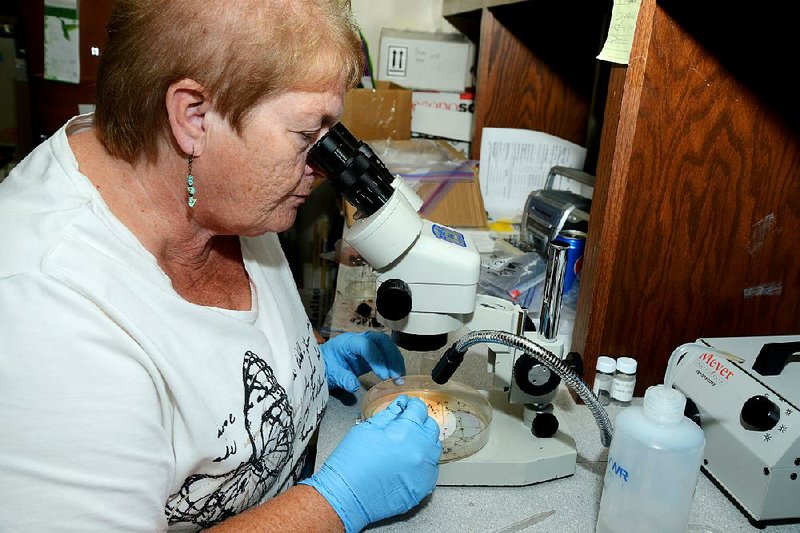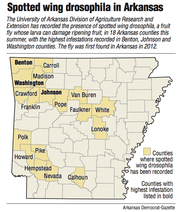A tiny fruit fly known as the spotted wing drosophila has farmers who grow raspberries, blackberries and nearly any other type of thin-skinned fruit in Arkansas on the alert.
The little bugs were first found in North America in California in 2008 and since then have been making their way across the United States, damaging fruit crops along the way. The University of Arkansas Division of Agriculture Research and Extension said recently that infestations have been found in 18 Arkansas counties, with the highest concentrations of the pests in Benton, Johnson and Washington counties.
Donn Johnson, professor and fruit and nut research extension entomologist for the division, said the key to holding the pests at bay and minimizing the damage they cause is awareness, education and vigilance.
He said the state has been holding workshops and fielding calls about the bugs to help farmers deal with the bug, which requires increased use of approved pesticides.
Sorting out the economic impact as the invasive pest makes its way across the country is difficult, experts say. In 2009, loss estimates for California were from zero to 80 percent based on location and the type of crop involved. Thin skinned fruits, including cherries, raspberries, blackberries, blueberries, strawberries, table grapes and wine grapes, are particularly vulnerable.
According to the 2012 Census of Agriculture, Arkansas had 305 farms producing noncitrus fruit on 2,006 total acres, down from 395 farms totaling 3,384 acres in 2007. Grape farms were a little less than half that number with 145 farms totaling 919 total acres.
In 2012, there were 126 blackberry farms with a total of 480 acres in the state; 131 domestic blueberry farms with 310 total acres; 28 raspberry farms totaling 26 acres; and 56 strawberry farms with 63 total acres.
Johnson said the key difference between the spotted wing drosophila and the standard vinegar fruit flies common to Arkansas is where the bugs lay eggs. The flies most people see seek out rotting fruit to lay their eggs while the spotted wing flies prefer a fresher target and therefore can cause much more damage.
"This one gets on fruit that's almost ripe," Johnson said.
The flies came from Japan and other areas of Southeast Asia, Johnson explained. He told a recent conference in Florida to discuss the influx that every state except Alaska has reported the insects. He said in Arkansas the flies increased dramatically during the last week of June and into July.
In less than a month the population went from less than two per trap per week to 93 per trap per week, according to a news release last week . While in Arkansas the flies have been discovered in blackberries, raspberries and late season strawberries, it's yet to be discovered in any samples of blueberries or grapes.
Spotted wing females lay their eggs in fruit and within a few days it will begin to break down as larva develop inside and feed, leading to discoloration and softening, with the fruit sometimes caving in on itself. The adult female lays just one egg per fruit but in her short lifespan can lay as many as 350 eggs.
To be on the lookout for the bugs, farmers are advised put traps in the field three weeks before ripening begins and check them weekly. Information on how to build and bait traps can be found at uaex.edu/publications/pdf/FSA-7079.pdf. To make certain the flies are spotted wing drosophila, farmers can take them to their local county extension office for examination.
Once detected, the best way to stop insects is weekly spraying of a recommended insecticide, experts with the extension service say. Farmers should spray again after rain and alternate types of recommended insecticides to help stop the fruit flies from growing resistant.
To help avoid damage by the fly, frequent and complete harvesting is suggested. Fruit not usable for market should be frozen for four days and disposed of or "solarized" by placing in a bag or under black plastic sheet to heat in the sun, which stops the flies from reproducing.
Sherry Sanders, the division's extension agent in White County, was the first to discover the flies in Arkansas, in 2012.
She said battling the bugs statewide, with farmers and homeowners who grow berries for their own consumption taking part, is an important aspect of keeping the flies from spreading farther.
"You have to watch for them and you have to have your arsenal ready," Sanders said, referring to keeping a variety of approved pesticides on hand for immediate use when the bugs are detected.
She added that proper use of pesticides is important, urging users to follow the directions on the label to ensure effectiveness, be aware of limitations on when fruit can be picked once it is sprayed, to not spray in rainy conditions, and to spray in the late evening or at night to avoid harming honeybees.
"Timing is crucial," Sanders said.
In 2008, California, Oregon and Washington state combined produced 76 percent of the U.S. commercial raspberry, blackberry, cherry, strawberry and blueberry crops, for a total value of $2.6 billion. A report by Douglas B. Walsh of Washington State University Irrigated Agriculture Research and Extension Center in Prosser, Wash., and others in 2011, assuming a yield loss of 20 percent in those five crops in the three states, indicated a potential annual loss of $511 million due to the flies.
"The damage has been hard to quantify since contaminants in the fruit aren't always detected," said Mark Bolda, strawberry and caneberry farm adviser with the University of California Cooperative Extension service in Santa Cruz County.
"However, shippers here in California have taken a zero tolerance to infestation, so the losses to the grower who doesn't address the issue can be very significant."
The eFly Spotted Wing Drosophila Working Group, organized to develop management strategies, includes entomologists, extension professionals, fruit growers and fruit marketers. A 2013 survey of growers in 28 states including Arkansas found losses due to the flies across all crops stood at $27.6 million, the group said in a report.
Johnson said detecting the flies and using pesticides properly will work as a stopgap but added long-term solutions that don't involve pesticides are being examined, including the use of screens or row covers. He said he has been working on solutions for organic farmers with the help of a grant from the U.S. Department of Agriculture.
Sanders said when the spotted wing drosophila was first detected on the West Coast and began to get closer and closer to Arkansas, she began to worry.
"I thought, uh-oh, we're next," she said.
SundayMonday Business on 08/17/2014

